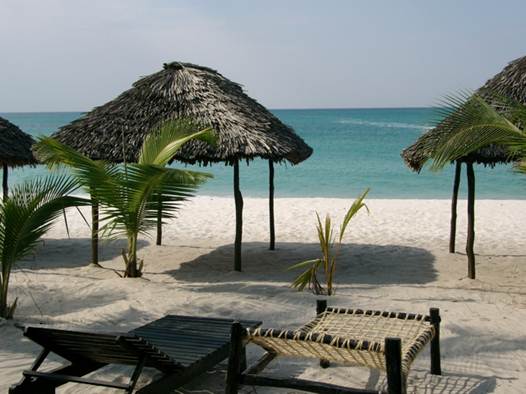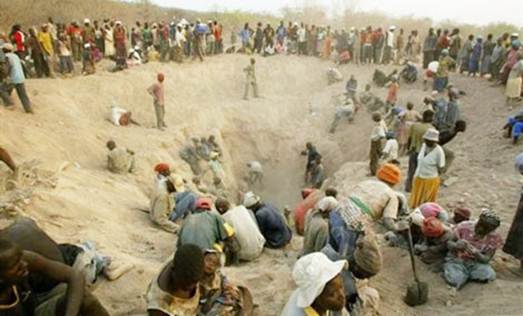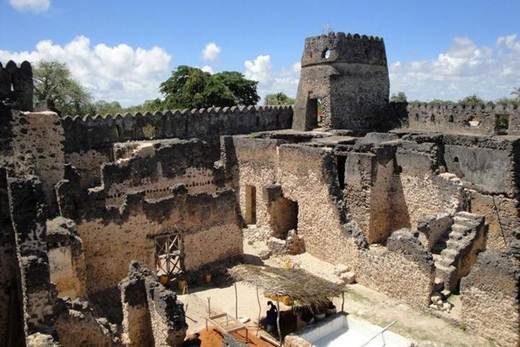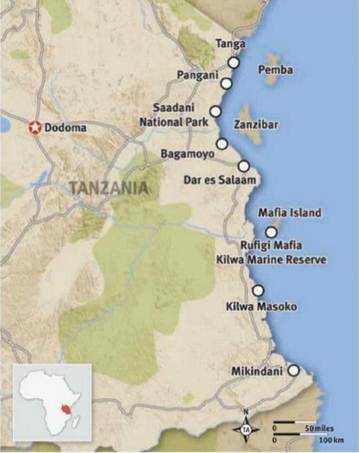The next stop, about 300km south of Dares
Salaam, past the massive and trackless Rufiji River delta, is Kilwa Masoko.
This soporific hamlet is seemingly stuck in a permanent stupor. Nothing moves
fast here, apart from pick-up trucks careering along the town's only paved
street and South African charter fishing boats speeding offshore. A spectacular
open-ocean beach at Masoko Pwani, 5km north of town, looks to be completely
forgotten by visitors and locals alike. Yet, somehow, this inertia and time
warp are a fitting backdrop, for it seems only a short step further back in
time to the glory days of Kilwa Kismani just offshore. Between the 13th and 15th
centuries this small island stood at the centre of a vast trading network
linking the old Shona kingdoms and the gold fields of Zimbabwe with Persia,
India and China. Its influence extended north past the Zanzibar Archipelago and
south as far as Sofala on the central Mozambican coast.

Dares
Salaam
We caught one of the dhows that sail
regularly across the narrow channel separating Kilwa Masoko and Kilwa Kisiwani,
landing on the beach just below a massive 19th-century Arabic-style fort and
near a group of young men eager to serve as guides. A short walk up from the
beach, and we stepped into the handsomely restored 15th century Great Mosque,
with its graceful vaulting and still intact columns. Crisscrossing from one
ruin to the next, we hopped across the centuries, finishing at the 12th-century
Husuni Kubwa complex. Taken together, the Kilwa ruins are among the most
significant groups of Swahili buildings on the East African coast, and
exploring them easily takes the full morning.

the
gold fields of Zimbabwe with Persia, India and China
From Kilwa the coast continues southwards
past the salt-producing centre of Lindi, once part of the Sultan of Zanzibar's
domain, and a terminus of the slave caravan route from Lake Nyasa. Further
south, and our last stop before the Mozambique border, is Mikindani, another
old Swahili trading town and regional headquarters of the German colonial
government.
Bush & Beach
Tazania’s coast and islands are fine
destinations on their own, but can also be easily combined with a saferi. Try
the classic two-week combination of seven to ten days in the northern circuit,
with the remainder spent relaxing on Zanzibar or Mafia. Or, a week-long
in-and-out of Dares Slaam itinerary split between Selous Game Reserve and Mafia
or Zanzibar.

Husuni
Kubwa complex
For history, beaches and diving plus
wildlife watching, try Mafia, Kilwa and Selous Game Reserve. Using local
flights, this itinerary can be comfortably enjoyed in seven to ten days. Road
transfers between Kilwa and Selous take seven to eight hours.
Another option combines the northern
circuit with Pangani (a half day's bus ride from Arusha) plus Zanzibar or
Pemba. Regular flights (mostly from the Tanga airfield) link Pangani with the
Zanzibar Archipelago, and there is a charter boat service from Pangani, Ushongo
and Saadani to Zanzibar.
Useful contacts include Coastal Aviation
(www.coastal.cc) and ZanAir (www.zanair.com), both with daily flights linking
the coast with Arusha and the northern circuit and linking the coast with
Selous Game Reserve. Coastal Aviation also continues to Ruaha National Park.
Safari Airlink (www.safariaviation.info) flies from Dares Salaam via Selous and
Ruaha to Katavi and Mahale Mountains parks in the west.
Plan Your Trip
Getting there
There are no direct flights from the UK or
USA to Tanzania's coast, but it is easily accessed via the international
airports at Arusha and Dar es Salaam, which are serviced by Kenya Airways
(www.kenya-airways.com), Ethiopian Airlines (www.flyethiopian.com), British
Airways (www.ba.com) and KLM (www.klm.com). Internal flights to make the final
leap to the coast are provided by Coastal Aviation (www.coastat.cc) and ZanAir
(www.zanair.com).
When to visit
June through October, during the long dry
season, is a great time to visit the Tanzanian coast. The short dry season
(January and February) is another pleasant period to visit.

Plan
Your Trip
Visas
Most visitors require a visa to visit
Tanzania. These are available upon arrival at airports and land borders. A three-month
tourist visa costs $50.
Books
Lonely Planet's Tanzania (5th Ed, 2012) by
Mary Fitzpatrick and Bradt's Tanzania with Zanzibar, Pemba & Mafia by
Philip Briggs (6th Ed, 2009) are both great accompaniments for trips to
Tanzania's coast.
Find out more
Zanzibar International Film Festival
(www.ziff.or.tz) Mnemba Island Lodge (www.mnemba-island.com) Chumbe Island
Coral Park (www.chum beistand.com) Saadani Safari Lodge (www.saadanitodge.com)
Tanzania Tourist Board (www.tanzaniatouristboard.com)
Author tip
Bring sturdy-soled shore shoes for beach
walking and for wading in the shallows at low tide (sharp shells and sea urchin
spines can give painful jabs). Look out for vitambuo (rice cakes), urojo (spicy
soup), grilled pweza (octopus) and other coastal delicacies. And don't cut your
travel time too short. Once here, you will not want to leave.